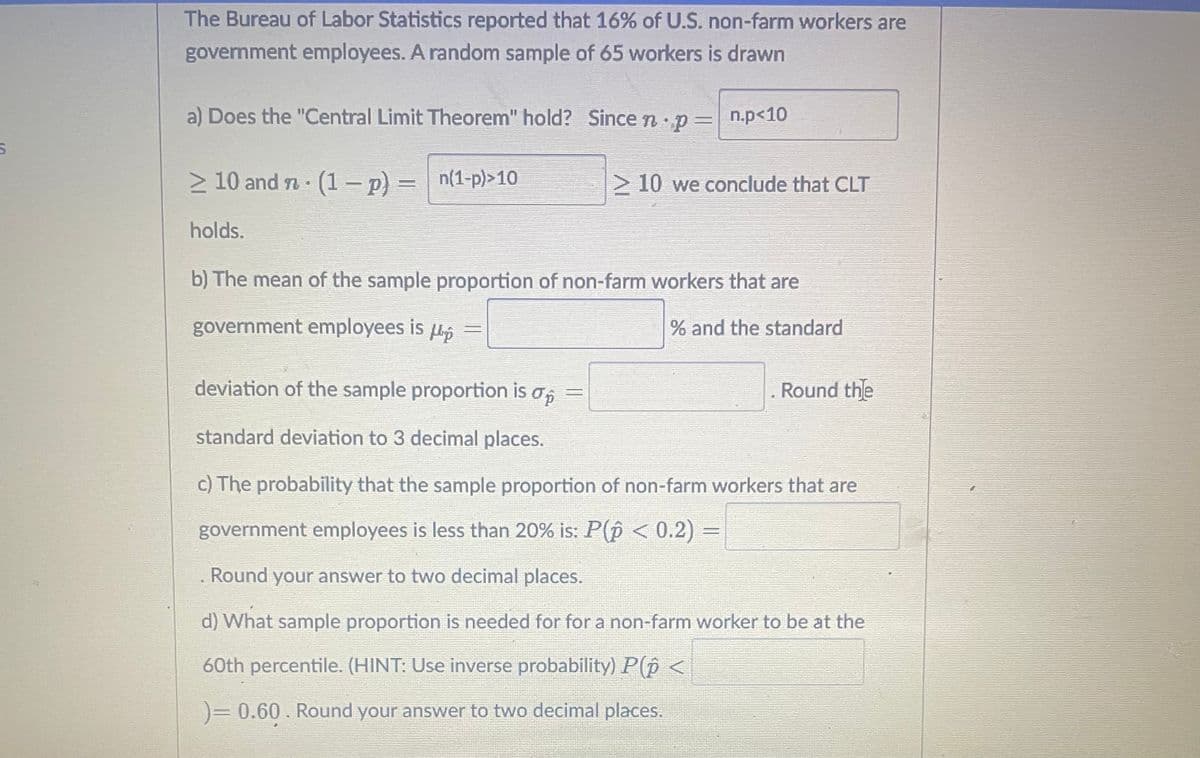The Bureau of Labor Statistics reported that 16% of U.S. non-farm workers a government employees. A random sample of 65 workers is drawn a) Does the "Central Limit Theorem" hold? Since n p = n.p<10 ≥ 10 and n (1-P) = n(1-p)>10 holds. > 10 we conclude that CLT b) The mean of the sample proportion of non-farm workers that are government employees is p = % and the standard deviation of the sample proportion is standard deviation to 3 decimal places. c) The probability that the sample proportion of non-farm workers that are government employees is less than 20% is: P(p < 0.2) = Round your answer to two decimal places. d) What sample proportion is needed for for a non-farm worker to be at the 60th percentile. (HINT: Use inverse probability) P(p < )= 0.60. Round your answer to two decimal places. op = Round the
The Bureau of Labor Statistics reported that 16% of U.S. non-farm workers a government employees. A random sample of 65 workers is drawn a) Does the "Central Limit Theorem" hold? Since n p = n.p<10 ≥ 10 and n (1-P) = n(1-p)>10 holds. > 10 we conclude that CLT b) The mean of the sample proportion of non-farm workers that are government employees is p = % and the standard deviation of the sample proportion is standard deviation to 3 decimal places. c) The probability that the sample proportion of non-farm workers that are government employees is less than 20% is: P(p < 0.2) = Round your answer to two decimal places. d) What sample proportion is needed for for a non-farm worker to be at the 60th percentile. (HINT: Use inverse probability) P(p < )= 0.60. Round your answer to two decimal places. op = Round the
Holt Mcdougal Larson Pre-algebra: Student Edition 2012
1st Edition
ISBN:9780547587776
Author:HOLT MCDOUGAL
Publisher:HOLT MCDOUGAL
Chapter11: Data Analysis And Probability
Section: Chapter Questions
Problem 8CR
Related questions
Question

Transcribed Image Text:5
The Bureau of Labor Statistics reported that 16% of U.S. non-farm workers are
government employees. A random sample of 65 workers is drawn
a) Does the "Central Limit Theorem" hold? Since n. p=
≥ 10 and n · (1 − p) =
n(1-p)>10
holds.
n.p<10
10 we conclude that CLT
b) The mean of the sample proportion of non-farm workers that are
government employees is p
=
% and the standard
=
deviation of the sample proportion is o
standard deviation to 3 decimal places.
c) The probability that the sample proportion of non-farm workers that are
government employees is less than 20% is: P(p < 0.2) =
. Round your answer to two decimal places.
d) What sample proportion is needed for for a non-farm worker to be at the
60th percentile. (HINT: Use inverse probability) P(p <
)= 0.60. Round your answer to two decimal places.
Round the
Expert Solution
This question has been solved!
Explore an expertly crafted, step-by-step solution for a thorough understanding of key concepts.
This is a popular solution!
Trending now
This is a popular solution!
Step by step
Solved in 5 steps with 2 images

Recommended textbooks for you

Holt Mcdougal Larson Pre-algebra: Student Edition…
Algebra
ISBN:
9780547587776
Author:
HOLT MCDOUGAL
Publisher:
HOLT MCDOUGAL

College Algebra (MindTap Course List)
Algebra
ISBN:
9781305652231
Author:
R. David Gustafson, Jeff Hughes
Publisher:
Cengage Learning

Algebra & Trigonometry with Analytic Geometry
Algebra
ISBN:
9781133382119
Author:
Swokowski
Publisher:
Cengage

Holt Mcdougal Larson Pre-algebra: Student Edition…
Algebra
ISBN:
9780547587776
Author:
HOLT MCDOUGAL
Publisher:
HOLT MCDOUGAL

College Algebra (MindTap Course List)
Algebra
ISBN:
9781305652231
Author:
R. David Gustafson, Jeff Hughes
Publisher:
Cengage Learning

Algebra & Trigonometry with Analytic Geometry
Algebra
ISBN:
9781133382119
Author:
Swokowski
Publisher:
Cengage

College Algebra
Algebra
ISBN:
9781305115545
Author:
James Stewart, Lothar Redlin, Saleem Watson
Publisher:
Cengage Learning

Elements Of Modern Algebra
Algebra
ISBN:
9781285463230
Author:
Gilbert, Linda, Jimmie
Publisher:
Cengage Learning,